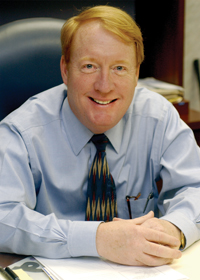
Gerald Hickson, M.D.
Malpractice costs can be curtailed: Hickson
Malpractice suits are unfortunate and painful for families and medical professionals, and they are expensive facts of life for large, multi-faceted health care institutions such as Vanderbilt University Medical Center.
But contrary to popular opinion, malpractice claims are not simply an uncontrollable cost of doing business, said Gerald Hickson, M.D., recently named director of VUMC Clinical Risk Reduction and Loss Prevention, and chair of Vanderbilt's Self Insurance Trust.
“Twenty years of research reveals that individuals and institutions can affect their levels of risk, and that medical professionals can work to make medical centers safer and kinder by proactively identifying and addressing recurring problems,” said Hickson, also associate dean for Clinical Affairs and a nationally recognized researcher in the area.
At Vanderbilt, the Self Insurance Trust is the funding mechanism that provides compensation for patients and families who have been injured by care and defends allegations that Vanderbilt believes are untrue.
“One key to controlling costs and improving safety is communication,” said Hickson. “After all, the best way to defend against litigation is to do everything you can to prevent problems from happening in the first place. Clear communication among members of the healthcare team and effective communication with patients and families are markers of a high quality organization.
“Stuff happens,” Hickson said. “And when bad outcomes occur, we want to do right by our patients: that is always our top priority. But we also want to carefully examine factors that may have contributed to an avoidable outcome — the system, technology, human issues — and see what can be addressed to prevent reoccurrences. It is all about identifying risk and doing the right thing for our patients now and for the patients we will see tomorrow.
“Whenever Vanderbilt personnel identify cases with potentially avoidable outcomes, the faster we can address the situation and communicate clearly with families the less likely those situations will escalate to circumstances where families are inclined to go to the courtroom.”
Traditionally, managing risk has been reactive in nature; focusing on limiting the institution's or medical group's financial liability and settling and paying claims. Those are still vital functions, but Hickson and the 20-member Self Insurance Trust Committee are embarking on a more proactive approach to risk management, one that seeks to foster communication across the Medical Center.
“Crew resource training lead by Dr. Drew Gaffney, associate dean for Clinical Affairs, is a critical program addressing some of the challenges that will on occasion lead us to the courtroom.”
Committee members routinely examine cases, seeking to understand why things have not gone well and consolidating this knowledge to share with leaders throughout the Medical Center.
The stakes are high. Hickson points out that the dollars spent defending cases and paying claims come directly from the Medical Center's bottom line.
“Say it costs $100,000 to defend a case in which we have done everything correctly. Even if we win the case, where does that money come from? It comes from the Medical Center, from monies that could have been used to support growth of programs in patient care, education, and research.”
“We are committed to doing the right thing by families who have been injured. That is who we are,” Hickson said. “We want to appropriately compensate those who have been injured, but more importantly we want to reduce the number of individuals who potentially have been harmed by care while at the same time promoting effective communication with families to reduce the number of families who go unnecessarily into our legal system.”













